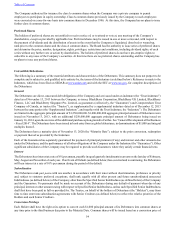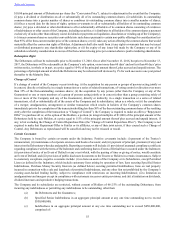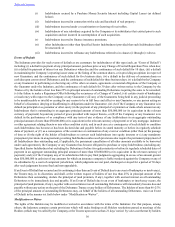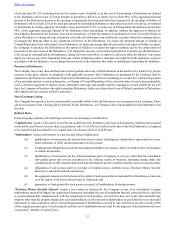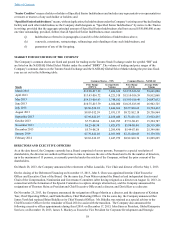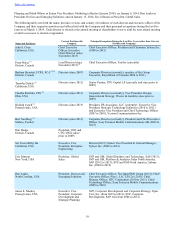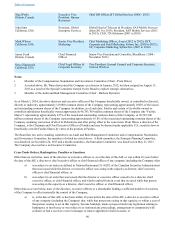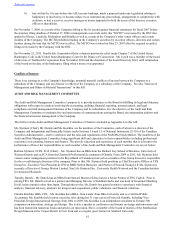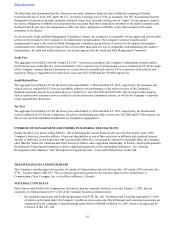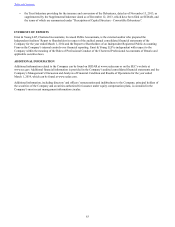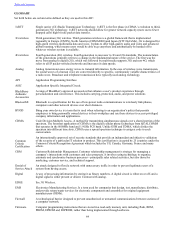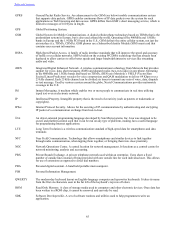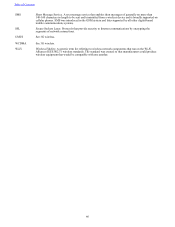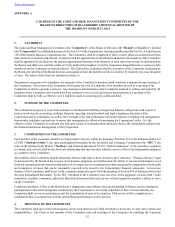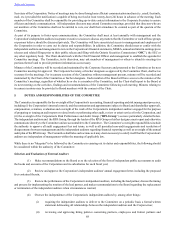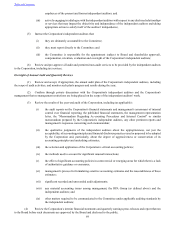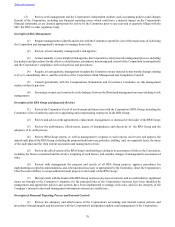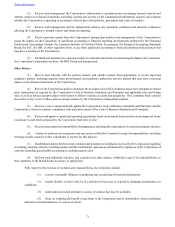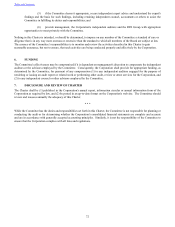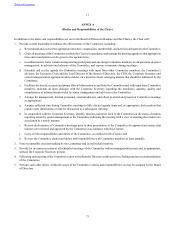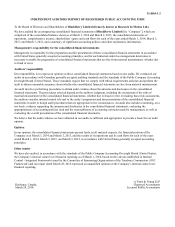Blackberry 2014 Annual Report Download - page 72
Download and view the complete annual report
Please find page 72 of the 2014 Blackberry annual report below. You can navigate through the pages in the report by either clicking on the pages listed below, or by using the keyword search tool below to find specific information within the annual report.
64
GLOSSARY
Set forth below are certain terms defined as they are used in this AIF:
1xRTT
Single carrier (1X) Radio Transmission Technology. 1xRTT is the first phase in CDMA’s evolution to third-
generation (3G) technology. 1xRTT networks should allow for greater network capacity (more users; fewer
dropped calls) high bit rate packet data transfer.
3G wireless
Third generation (3G) wireless. Third generation wireless is a global framework that is implemented
regionally in Europe (UMTS), North America (CDMA2000) and Japan (NTT DoCoMo). 3G is designed for
high-speed wireless multimedia data and voice. It plans to offer high-quality audio and video and advanced
global roaming, which means users would be able to go anywhere and automatically be handed off to
whatever wireless system is available.
4G wireless
Fourth generation (4G) wireless. Fourth generation is successor to 3G and 2G standards. The nomenclature
of the generations generally refers to a change in the fundamental nature of the service. The first was the
move from analog to digital (2G), which was followed by multi-media support (3G) and now 4G, which
refers to all IP packet-switched networks and increases in data speeds.
Analog
Analog transmission uses energy waves to transmit information. In the case of wireless voice transmission,
the sound waves of a human voice are converted directly to specific, continuously variable characteristics of
a radio wave. Broadcast and telephone transmission have typically used analog technology.
API Application Programming Interface.
ASIC Application Specific Integrated Circuit.
BlackBerry
Authentic
Accessories
A range of BlackBerry approved accessories that enhance a user’s product experience through
personalization and convenience. This includes carrying, protection, audio, and power solutions
Bluetooth®
Bluetooth is a specification for the use of low-power radio communications to wirelessly link phones,
computers and other network devices over short distances.
BYOD Bring your own device is a term that is used when referring to an organization’s policy that permits
employees to bring personally owned devices to their workplace and use these devices to access privileged
company information and applications.
CDMA
Code Division Multiple Access. A method for transmitting simultaneous signals over a shared portion of the
spectrum. The foremost application of CDMA is the digital cellular phone technology from QUALCOMM
that operates in the 800MHz band and 1.9GHz PCS band. Unlike GSM and TDMA, which divides the
spectrum into different time slots, CDMA uses a spread spectrum technique to assign a code to each
conversation.
Common
Criteria
Certification
An internationally approved set of security standards that provide an independent and objective validation
of the security of a particular IT solution or product. This certification is accepted by 25 countries under the
Common Criteria Recognition Agreement which includes the US, Canada, Germany, France and many
others.
CRM
Customer Relationship Management. Customer relationship management is strategy for managing a
company’s interactions with customers and sales prospects. It involves using technology to organize,
automate and synchronize business processes—principally sales related activities, but also those for
marketing, customer service, and technical support.
Denial of
Service Attack
An attack designed to flood a network with unnecessary traffic in order to prevent legitimate users of a
system from having access.
Digital
A way of processing information by storing it as binary numbers. A digital circuit is either on or off, and a
digital signal is either present or absent. Contrast with analog.
EDGE See 3G Wireless.
EMS
Electronics Manufacturing Services. Is a term used for companies that design, test, manufacture, distribute,
and provide return/repair services for electronic components and assemblies for original equipment
manufacturers (OEMs).
Firewall
A technological barrier designed to prevent unauthorized or unwanted communications between sections of
a computer network.
Firmware
Computer programming instructions that are stored in a read-only memory unit, including flash, ROM,
PROM, EPROM and EEPROM, rather than being implemented through software.
Table of Contents


